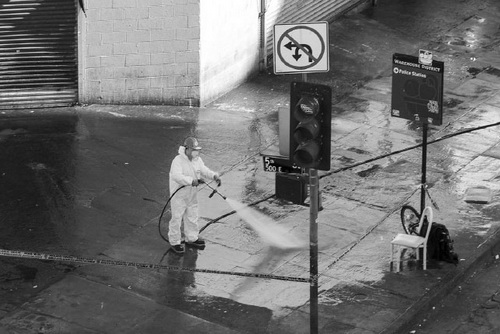Toilet Crisis on Skid Row

Leslie Evans
In January and February, 24 people from 15 organizations, calling themselves the Los Angeles Central Providers Collaborative, conducted an audit of toilets available to the homeless in Downtown’s 50-block Skid Row. Their shocking findings became headline news when they released their 64-page report, “No Place to Go,” in late June. For a nighttime unsheltered population they listed at 1,777, they found only 9 working public toilets, all of them at a single location: the Midnight Mission shelter, 601 S. San Pedro Street. This is eight blocks from the northeast and northwest corners of Skid Row and 9 blocks from the southeast border. A long walk at night. The number of estimated users was taken from the 2016 homeless count, and is today more than 2,000.
At the best of times, during the day, there are only a nominal 69 public toilets in Skid Row. Five are automated self-cleaning units, 8 porta potties in two public parks (closed at night), and 56 toilets at shelters and other homeless service providers. These numbers are misleadingly high, however. The auditors found 38% of the toilets not available during promised open hours. The five automated units are closed at night, and only one of them was working during the day. These have a bad reputation among the homeless in any case, as the little structures are often taken over by drug dealers or prostitutes and are regarded as unsafe.
The report declares, “Many public toilets lack stalls, doors or doors that lock. Most public toilets are infrequently maintained; many are soiled with fecal matter and debris. Many public toilets require the user to request individual sheets of toilet paper from a security guard. Most lack sinks for washing hands, soap, paper towels, toilet paper, seat covers, and menstrual products.”
Only two of the porta potties were ADA accessible, and fecal matter on the floor meant that wheelchair-bound users must roll through the feces and then place their hands on the wheels to move on. This also happens to wheelchairs on Skid Row sidewalks.
The report made a major point of comparing Skid Row toilet facilities to UN standards in refugee camps. The UN High Commission for Refugees requires one toilet for every twenty persons, with no camp residents more than 50 meters (164 feet) from a toilet. The UN standard would require 89 toilets at night and 186 in the daytime. As for distance, from the Midnight Mission at 6th and San Pedro to the edge of Skid Row at 7th and Alameda Streets is .7 mile, or 3,696 feet.
This inhumane situation for the homeless is also an incipient public health disaster that has been in the making for many years. A 2012 LA County Department of Public Health survey of Skid Row found the lack of toilets, and the widespread use of the sidewalks and doorways in their place, to pose a substantial risk for spreading the following diseases:
“Meningitis, respiratory infections, enteric pathogens such as Hepatitis A and Salmonella, Staphylococcus Aureus skin infections, Tinea infections [fungal], Pediculosis infections [lice], diarrheal disease, Tuberculosis, HIV, Hepatitis B and C, and Typhus.”
Andy Bales, head of the Union Rescue Mission, told the London Guardian, “We should not let any human being experience that kind of embarrassment of indignity or shame of having to utilize a sidewalk for a restroom, let alone live in the filth.” (June 30)
Mayor Garcetti has budgeted $1.4 million for more Skid Row toilets for the 2017-18 fiscal year. But solving the problem goes far beyond porta potties. Skid Row is a high crime area and many of the homeless are mentally ill and destructive of unguarded restrooms. People are afraid to use unstaffed toilets on dark streets at night, and unstaffed units often have the toilets stuffed with trash.
The LA Times in a July 13 editorial said, “the city needs to tackle this problem with more urgency (and not just in downtown L.A.). If it’s safest to set up portable toilets in a parking lot with security guards, then the city should be persuading private property owners downtown to open up their lots at night for city-funded and secured portable toilets.”

San Francisco Pit Stop portable toilets.
The city government has announced that it will try to put up 10 more toilets by mid-September. The “No Place to Go” report proposed that Los Angeles emulate San Francisco’s Pit Stop Program. That city’s Public Works Department maintains portable toilets, and a few of the more permanent self-cleaning installations, at 15 locations in the city. The dual units are mounted on trailers and taken in nightly for cleaning. They include a sink for washing. The key to success has been having an attendant at each installation, to discourage vandalism and provide a sense of safety. The workers are mostly homeless people, supplied by local nonprofits at modest wages. The program has saved large costs in power washing sidewalks in affected areas.
For a copy of the report:
http://www.innercitylaw.org/wp-content/uploads/2017/07/No-Place-To-Go-final.pdf

Los Angeles Skid Row self-cleaning toilet.
Comments
Leave a Reply
You must be logged in to post a comment.



